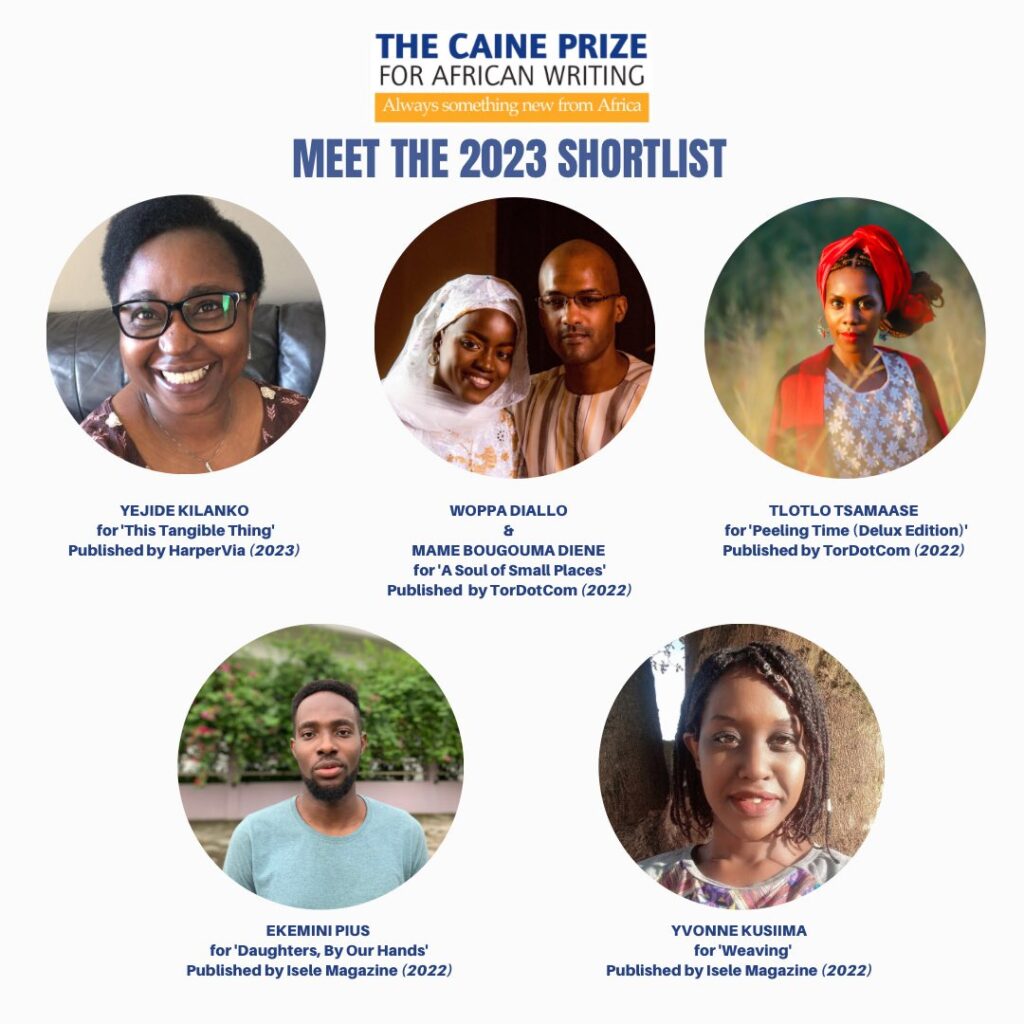As usual, the shortlist consisted of five stories representing writers from different parts of Africa vying for the £10000 pounds award…
By Chimezie Chika
On July 8th 2023, the shortlist for the AKO Caine Prize for African Writing was announced. Over the years, the Caine Prize has garnered much prestige and acclaim, boasting among its past winners some of Africa’s most important writers, including Leila Aboulela, Yvonne Owuor, Binyavanga Wainaina, Helon Habila, NoViolet Bulawayo, and others. As usual, the shortlist consisted of five stories representing writers from different parts of Africa vying for the £10000 pounds award. On this year’s shortlist are Yejide Kilanko who was shortlisted for her story, “This Tangible Thing”; Tlotlo Tsamaase for her story, “Peeling Time”; Woppa Diallo & Bougouma Diene’s “A Soul of Small Places”; Ekemini Pius’ “Daughters, By Our Hands”; and Yvonne Kusiima’s story, “Weaving.” It is notable that four out of the five stories are published in journals or anthologies edited by Africans.
(Read also: Obinna Udenwe’s The Widow Who Died with Flowers in Her Mouth Features Explorations of Loneliness and Redemption)
Yejide Kilanko’s “This Tangible Thing” is a tale of love, aging, and all the old bonds that tie a family together. It follows Bibiire Kuku, an old widow coming to terms with old age, as she learns what it means to love her granddaughter who had been dealing with trauma in Canada. Kilanko’s story uses this rather straightforward conduit to explore themes of culture, diasporic trauma, mortality, and the subtle connections between familial love and history. Kuku’s character is well-drawn. We encounter a woman who, in many ways, has lived a full life and feels that need to impart all that she knows on her “mute” granddaughter. What we learn finally is that trauma can sometimes be healed by a simple act of love and understanding. Kilanko’s themes are thought-provoking, her narrative nuanced and mature.
Tlotlo Tsamaase’s “Peeling Time” is a story that defies easy categorisations. It is a postmodern tale of a musician, Motsumi, who uses an advanced technology to kill and extract women’s souls and essence which he uses in creating his music. Motsumi—if we are to take the story literally, for its purposes are not always clear—exists in two realms. In one he time-travels to a world which is ruled by tyrannical technology that seeks to have a stake in his life; in another he is using this alien technology he acquired from the distant realm to conduct his musical creations. Or, perhaps, he exists in both worlds simultaneously, slipping in and out at will. He seems to sap the energies of each girl he settles upon; in their lives’ essence exists the substance of his music. Many times I often found myself in a queasy struggle to sustain an interest in this story. The onslaught of disparate images from different connections did not help.
The story is structured as music lyrics; its narration is highly fragmented and chaotic. It seems to delight in confusion and cryptic postmodern games. Whatever Tsamaase’s purpose seems to be, it would have served her well if she had employed a more straightforward structure. There are too many things going on here and little explanation as to how it all came about. The most important attribute of good writing is clarity, a quality which seems elusive in “Peeling Time.” The technology takes centre stage. Sometimes, certain types of sci-fi falls victim to this situation in which the science overshadows the storytelling. There is great potential here, no doubt, but it is not clear how much of that potential is attained.
Woppa Diallo & Bougouma Diene’s “A Soul of Small Places” is perhaps the best story on the shortlist. It is the story of a young girl who discovered that she is possessed by a man-eating jinn. Set in a Senegalese village, it is a mythical tale of a girl’s fight against forces greater than her. There are so many levels to this story. From its first sentence (“My name is Woppa Diallo”) we are drawn into a world that becomes more and more outlandish. For a long time, Woppa Diallo’s village is besieged by herdsmen who kidnap and rape young girls. It does not help that the village is small and isolated. At first Woppa Diaillo does not have full access to the jinn in her. The jinn overwhelms her consciousness whenever she is in danger. She becomes a beast tearing away herdsmen body part by body part. Woppa Diallo’s jinn is supremely destructive and bloodthirsty. While her newfound powers helps her protect her family and village, the jinn gains on Woppa Diallo’s consciousness so that she begins to descend more and more into her beastly mode and can no longer resist its blood thirsty pull.

The duo authors of “A Soul of Small Places” cleverly merges myth and fantasy in this tale of fear, violence, survival and sacrifice. There is myth everywhere in this story: in a boulder by the riverside, in the people’s beliefs, in the idea of a benevolent monster. The best thing about this story is the language and the voice, the gentle flow of words. In reading, there is always that feeling of an ancient legend being told by an old man. There is wisdom in the voice, there is mystery in the time and place, and there is nostalgia in the ambiance of the prose.
(Read also: Emmanuel Iduma’s I am Still with You Contemplates War, Loss, and the Burden of Memory)
Yvonne Kusiima’s “Weaving” is a ‘voice’ story; by which I mean that it is a story in which more is revealed from the uniqueness of the main character’s voice than in any other tool of narration. It is the story of adolescent naiveté. Thomasina’s voice is delightfully colloquial and digressive in this roaring yarn of a tale. She has a Holden Caulfield-like personality; she has something to say about everything. Thomasina is very opinionated, but only in a childlike way. Perhaps this is why she fails to see that her crush’s real intent is not sincere. Even when she gets pregnant, Thomasina does not lose her naivete. One of the best things about this story is Thomasina’s curious combo of naive knowledge, and observation.
“Weaving” is the funniest story on this year’s Caine Prize shortlist. Its laugh-aloud humour comes with all the beliefs and quirkiness of a child: of mosquito Thomasina says, “Jessica and I sleep under a mosquito net, but they sleep inside with us.” The energetic narration is buoyed by Thomasina’s extremely active mind, a restless manner that allows her to make the most striking observations about things. Thomasina’s coming of age introduces her to the brutal reality of societal stigma and familial loyalties. Kusiima’s “Weaving” is a good story and one that may yet convince the judges. The likes of it have made it to the Caine Prize winners’ list before.
Ekemini Pius’ story, “Daughters, By Our Hands,” is a conceptual story in which the story seems to be more about the concept than any other thing. A quick synopsis is that this is the story of an alternate future in which men do not exist and women have been genetically modified so that they can impregnate themselves by means of their finger nails. The ten nails available on the hands means a possible ten girls (the women never give birth to boys). The thing with Pius’ story is that there is nothing else to see here apart from the concept. The language and other narrative devices are commonplace; in short, there is no “wow” factor. But there are very strong feminist themes here.
The problem of Pius’ story shows clearly that literature should be more than just subject matter; if it were just that, then most stories would be mere journalistic reportage. Alas, journalistic reportage is not literature in the sense in which we understand literature as art. Literature is not about concept or propaganda. Literature can conceptualise and/or put ideas forwards, insofar as these ideas and concepts are subsumed in art. It is my belief that literature that pushes propaganda—in such a way that the propaganda overwhelms its artistic merit—is little more than picketing, pamphleteering and onsite activism. In fact, it is anything but literature.
The stories in this year’s shortlist are almost entirely female-based, but the themes and subject matters selected by the all-female judging panel, including Jendella Benson, Kadija George Sesay, Warsan Shire, Edwige-Renee Dro, and the chair of judges, Fareda Banda—are diverse. Three of the stories are speculative fiction, which is a good thing for the genre. While others have strong female characters at the centre, others are more about concepts than characters or narratives. There are bright and dull lights here, but it is my hope that the bright lights win in the end. One bright light, “A Soul of Small Places,” will perhaps validate my taste.
Chimezie Chika’s short stories and essays have appeared in or forthcoming from, amongst other places, The Question Marker, The Republic, The Shallow Tales Review, Isele Magazine, Lolwe, Efiko Magazine, Brittle Paper, and Afrocritik. He is the fiction editor of Ngiga Review. His interests range from culture to history, art, literature, and the environment. You can find him on Twitter @chimeziechika1.




This is an indept review that feels as good as reading the shortlisted stories.
You can find another review we have also written at newstoweronline.blogspot.com
Yiro